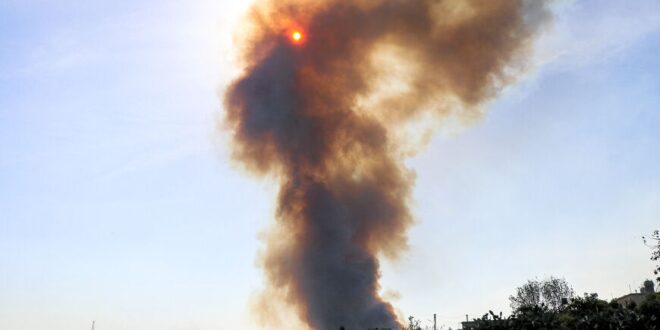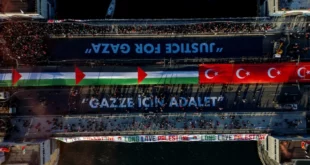Hezbollah has been careful not to escalate the situation along Israel’s northern border beyond the accepted norms, but the situation could change quickly depending on events in Gaza.
South Lebanon is beautiful in autumn. The green landscape, the blue sea, and the perfect weather encourage feelings of serenity. On Oct. 8, however, another cycle of tit-for-tat exchanges between Israel and Hezbollah interrupted the festival of colors and any tranquility.
The day before, Hamas had launched its unprecedented attack on Israeli communities bordering Gaza, killing and injuring thousands and capturing over 200 people to hold as hostages in Gaza.
From the start, it became clear to Hezbollah — and to the Iran-backed armed groups in Iraq, Syria, Lebanon, Yemen and the Palestinian territories — that Hamas wouldn’t be able to handle the situation alone.
The day after Hamas members crossed into Israel, Hezbollah attacked military posts in the disputed Shebaa Farms area, a piece of land held by Israel and claimed by the government in Beirut. That operation stayed within the rules of the game: directly attack military posts across the border, refrain from targeting civilians.
Oct. 9 brought an attack on the so-called Blue Line — the UN-patrolled boundary separating Israel from Lebanon — in an operation claimed by Palestinian Islamic Jihad, and the next day, Hamas followed suit with a missile attack along the border. Both were unusual events in that Palestinian groups have rarely operated on Lebanon’s border since Israel’s 1982 invasion and the expulsion of the Palestine Liberation Organization to Tunisia.
At this point, it remains unclear what the current situation will ultimately mean for Hezbollah’s rules of engagement on the Israel-Lebanon border.
Life on the edge
Of late along the 120 kilometers of Lebanon’s southern border, only a few villagers have been moving about as plumes of smoke hang in the distance, above the Israeli military positions targeted by Hezbollah fighters. In the town of Dheira, in Lebanon’s southwest, several of the houses have recently taken hits by shells. As the sound of an Israeli drone ruptured a rare moment of silence, one resident contemplating when the shelling would end, remarked, “It gets pregnant in Gaza and gives birth in Dheira.”
In the Christian town of Alma Ashaab, some 90% of the residents have fled. The village priest, saying goodbye to two nuns leaving for Beirut, remarked that only 50 people remain.
“We don’t have shelters to hide in,” the priest told Al-Monitor. “No one is asking about the people.” Until the current escalation, he said, his town had been among the safest places in the world.
“Now people are seeking refuge farther away. The trauma they went through during the 2006 war was too difficult — more than 150 buildings in the town were destroyed,” he said.
The only positive aspect of the current reality is that both Hezbollah and Israel are sticking to the post-2006 method of counterdeterrence that keeps the fight confined to the border area: Israel shells to a depth of 4-5 kilometers inside Lebanese territory, while Hezbollah — and occasionally Islamic Jihad, Hamas and al-Fajr forces — attack the same distance inside Israel, targeting military positions, infantry and cities with antitank missiles, rockets and machine guns.
During the first few days of the escalation, the road adjacent to the border became a zone of operations, attracting the attention of journalists, who roamed the area in their blue flak jackets and helmets. After Oct. 13, when two Israeli missiles killed Reuters videographer Issam Abdallah and injured several other reporters, coverage from the area decreased gradually as both Israel and Hezbollah refused to let an attack go unanswered. In this regard, Israel sent a clear message to Hezbollah that it considers the group fully responsible for any attack from the Lebanese border.
What does Hezbollah want?
Hezbollah’s main objective has been to delay or prevent an Israeli ground offensive in Gaza while conveying to the United States that it and other Iranian-backed groups will not allow Hamas to be easily crushed. The more pressure on Hamas, the more the tension will increase.
At the funeral of a Hezbollah fighter on Oct. 21, the party’s deputy secretary general, Naim Qassem, made the organization’s thinking clear when he said, “Do you believe that if you try to crush the Palestinian resistance, other resistance fighters in the region will not act? We are in the heart of the battle today. We are making achievements through this battle.”
Near the border with Israel, a Hezbollah commander explained to Al-Monitor that Israel and Hezbollah update their rules of engagement on a daily basis.
“Hezbollah succeeded over the past years in deterring Israel, that’s why they don’t dare to expand the war on this front,” the commander added. “The border with occupied Palestine is the battle zone, but whenever they use a new weapon in the battle, the resistance on its side goes a step further.”
The Lebanese group has lost close to 45 fighters since the beginning of the Israel-Hamas war. Most of the casualties came after Israel began using drones and warplanes to target Hezbollah cells attacking its military positions. Hezbollah’s focus has been on destroying the Israeli military’s communication and monitoring system along the border. Hezbollah media has documented and published several of the attacks on Israeli infantry and tanks on their Telegram channel.
Gaza at what cost?
Hezbollah and its allies are waging a multilayered tactical war with strategic goals. The first goal is to distract and divert Israel from the battle in Gaza and its planned ground campaign by keeping its military so busy in the north that the Israeli leadership begins to consider whether the cost of a battle in Gaza might be too high. This could potentially end up being a secondary conflict that evolves into a primary confrontation on Israel’s northern border, greatly heightening tensions in the region as a whole.
In fact, Iranian-back groups are exploiting their geographical leverage in Iraq, Syria and Yemen as well as Lebanon to increase the possibility of a regional conflict. In this regard, the message is mainly directed at the United States and its Western allies in the hope that launching rockets from Yemen and attacking US military positions in Syria and Iraq will push Washington to restrain Israel from a large-scale incursion into Gaza.
Choreographed steps have already been taken, from the front in Lebanon to the diplomatic signaling by Iranian Foreign Minister Hossein Amir-Abdollahian to the threats by Iraqi and Yemeni groups.
The main bet is that Israel can’t win on two fronts, so a regional escalation is something the United States will exert a real effort to prevent. President Joe Biden’s messaging following his visit to Israel has been interpreted as a sign of this.
Israel’s perspective on the conflict has shifted from one of confronting a mere security threat to dealing with an existential challenge that cannot be disregarded, especially in light of the activity to the north. The current situation is prompting doubts about Israel’s deterrence capabilities, and with Israeli Prime Minister Benjamin Netanyahu facing another significant challenge, all sides are reassessing their strategy, raising concerns about potential misjudgments.
 Eurasia Press & News
Eurasia Press & News



